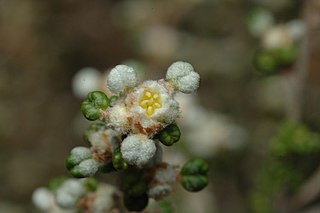
Phebalium daviesii, commonly known as St Helens wax flower or Davies' wax flower, is a species of shrub that is endemic to a restricted area in Tasmania. It is more or less covered with silvery or rust-coloured scales and has narrow wedge-shaped leaves with a notched tip, and umbels of white to cream-coloured, five-petalled flowers.

Cyanothamnus anemonifolius, commonly known as narrow-leaved boronia or sticky boronia, is a flowering plant that is endemic to south-eastern Australia. It is a shrub with mostly pinnate leaves, with white to pale pink four-petalled flowers in leaf axils.

Boronia citriodora, commonly known as lemon-scented boronia, lemon plant or lemon thyme, is a woody shrub that is endemic to Tasmania. It has pinnate leaves and white to pink flowers that are arranged singly or in groups of up to seven, in the leaf axils or on the ends of the branches.

Cyanothamnus nanus, commonly known as the dwarf boronia or small boronia is a plant in the citrus family Rutaceae and is endemic to eastern Australia. It is a prostrate or low spreading shrub with simple or three-part leaves and white or pale pink four-petalled flowers.

Boronia hemichiton, commonly known as Mt Arthur boronia is a plant in the citrus family Rutaceae and is endemic to Tasmania. It is an erect, woody shrub with compound leaves and pink or white, four-petalled flowers.

Boronia hippopalus, commonly known as velvet boronia is a plant in the citrus family Rutaceae and is endemic to Tasmania. It is an erect, woody shrub with pinnate leaves and white to pink, four-petalled flowers.

Boronia jucunda is a plant in the citrus family Rutaceae and is endemic to the far north-west of Australia. It is an erect shrub with many branches, pinnate leaves and white, four-petalled flowers. It is only known from a small area in the Kimberley region in Western Australia and in a national park in the Northern Territory.

Cyanothamnus occidentalis, commonly known as the rock boronia, is a plant in the citrus family Rutaceae and is endemic to eastern Australia. It is an erect, woody shrub with pinnate or bipinnate leaves and groups of up to three white to pale pink, pink four-petalled flowers arranged in leaf axils.

Boronia pilosa, commonly known as the hairy boronia, is a plant in the citrus family Rutaceae and is endemic to south-eastern Australia. It is an erect, woody shrub with hairy branches, pinnate, sometimes hairy leaves and groups of up to ten white to pink, four petalled flowers.

Boronia rhomboidea, commonly known as the broad-leaved boronia or rhomboid boronia, is a plant in the citrus family Rutaceae and has a disjunct distribution in New South Wales and Tasmania in Australia. It is an erect, woody shrub with many branches, simple, broadly egg-shaped to almost circular leaves and groups of up to three white to pale pink, four-petalled flowers on the ends of the branches or in the axils of the upper leaves.
Boronia anomala is a plant in the citrus family Rutaceae and is only known from a single population growing under an overhang in a sandstone gorge in the Kimberley Australia region of Western Australia. It is an erect, mostly hairless shrub with pinnate leaves and four-petalled flowers.

Boronia elisabethiae is a plant in the citrus family Rutaceae and is endemic to Tasmania. It is a semi-erect or weakly spreading, woody shrub with pinnate leaves and white to pink, four-petalled flowers.
Cyanothamnus montimulliganensis is a plant in the citrus family Rutaceae and is endemic to a single mountain in Queensland. It is an erect, woody shrub with pinnate or bipinnate leaves and white, four-petalled flowers usually arranged singly in leaf axils.
Boronia rozefeldsii, commonly known as Schouten Island boronia, is a species of plant in the citrus family Rutaceae and is endemic to a small Tasmanian island. It is an erect, woody shrub with pinnate leaves and pink, four-petalled flowers. It is similar to B. pilosa which grows on the same island, but has larger petals and fewer hairs on the leaflets.

Correa lawrenceana var. lawrenceana is the implicit autonym of Correa lawrenceana and is endemic to Tasmania. It is a shrub with papery, oblong leaves and pale green, narrow cylindrical flowers arranged singly on the ends of branchlets.

Lasiopetalum membranaceum is a species of flowering plant in the family Malvaceae and is endemic to a small region of eastern Tasmania. It is a low, spreading shrub with thin, rusty-hairy branches, narrow oblong leaves and drooping, star-shaped red to greyish-pink or white flowers.

Spyridium lawrencei, commonly known as small-leaf spyridium or small-leaf dustymiller, is a species of flowering plant in the family Rhamnaceae and is endemic to Tasmania. It is an erect, compact or straggling shrub with small, leathery, round to heart-shaped leaves, and dense heads of hairy, cream-coloured flowers.

Cryptandra alpina, commonly known as alpine pearlflower, is a species of flowering plant in the family Rhamnaceae and is endemic to Tasmania. It is a small, prostrate shrub with slender branches, linear leaves, and tube-shaped white flowers arranged singly on the ends of branches.

Spyridium obcordatum, commonly known as creeping spyridium or creeping dustymiller, is a species of flowering plant in the family Rhamnaceae and is endemic to Tasmania. It is a prostrate shrub with heart-shaped leaves, the narrower end towards the base, and clusters of hairy, white flowers.

Billardiera macrantha is a species of flowering plant in the family Pittosporaceae and is endemic to south-eastern Australia. It is a slender twiner with narrowly elliptic leaves and yellowish-green flowers arranged singly on thin, pendent peduncles. This species is often confused with the similar Tasmanian endemic, Billardiera longiflora.



















